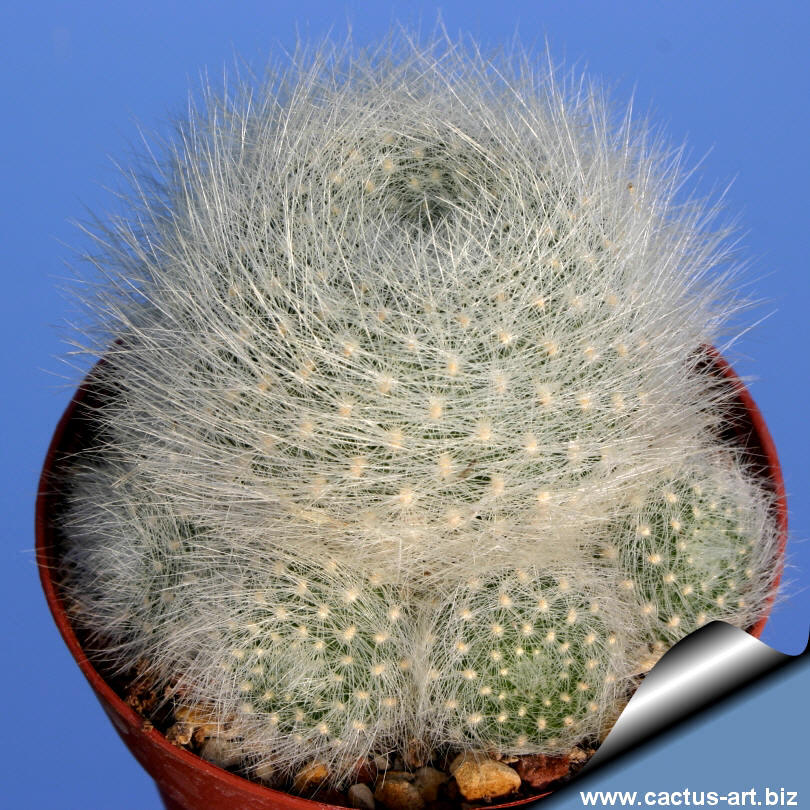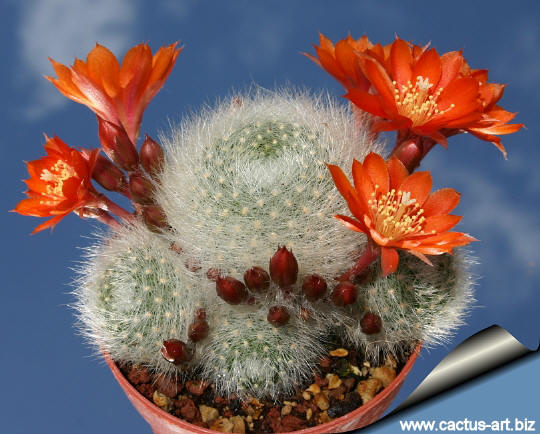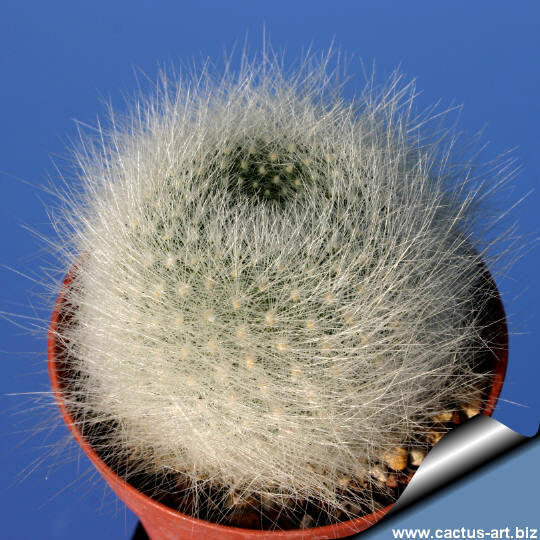|
|
|

This species has an uncommon appeal,
and is grown for its beautiful
cream-white spines on fuzzy balls.
It
also produces vibrant orange-red flowers.
|
|
Description: Rebutia albipilosa
is a plant from northern Argentina. It's a white-furrowed cactus with
dense, long, white bristles and a large main body, with several offsets
that bloom sparely but regularly.
Stem: Flattish, 3-8 cm wide, 4-6 cm tall.
It
would appear that in cultivation they grow larger and cluster more
vigorously than in habitat.
Spines: White or cream-white, fine, long and soft, that cover the
plant body.
Flower: Deep orange, funnel-shaped, 2 cm in diameter, from the base
of the stems.
Fruit: Tiny, berrylike, hidden among the spines, bursting when
ripe. |
|
Cultivation: This species is easy to cultivate in a very open
mineral mix, (lots of pumice). It requires careful watering to keep plant
compact and maintain strong and dense spines. Rebutia
albipilosa tends to rot if too wet, and
is best kept in a somewhat
sheltered location. Keep dry in winter.
Hardy to -4°C. Give them
an airy spot and ensure good drainage, with soil at least
50% sand or pumice grit.
It is better that they be repotted regularly.
Repotting will increase the number and size of stems,
and will increase the number of flowers produced.
Repot yearly until
reaching about 100 mm in size, then every two or three years will
suffice. Repotting is best done at the end of winter, but
it can be done at
other times,too. Do not water for a couple of weeks after repotting, to
reduce risk of root rot via broken roots. A layer of 'pea' gravel
at the bottom of the pot improves drainage. A layer of decorative gravel
as a top dressing helps prevent the caking of the potting mix, which
decreases the rate of water absorption. It also keeps the perlite and
pumice from blowing everywhere, and looks nice.
Pots should be only slightly larger than the plant and root system.
Keep dry in winter. Hardy to -4°C for a short period.
Rebutias
grow in nature at high altitudes, and do not thrive well at high
temperatures in cultivation. They will often go dormant in mid-summer,
and resume growth again when the weather cools in late August.
They can
tolerate amazingly low temperatures for long periods of time.
All
species can take a frost, even when not bone dry.
It is generally
accepted that plants kept at too high a temperature, or watered too much
during the winter rest period, will not bloom the following year.
The
plants can be placed outdoors in April, but protected from rain and
direct sunlight. Some plants will scorch if placed in direct sun too
quickly. Water them thoroughly when placed out, and again in two weeks,
and again in one week. After one month the plants are ready to be placed
out in full sun and full rain for the summer. During dry spells the
collection is watered once a week, during hot dry spells, twice a week.
All, especially the young
plants, are susceptible to red spider mites.
Propagation: Offsets, seeds.
|
|


Advertising
|
|
|
|
|
Family:
Cactaceae (Cactus
Family) |
Rebutia albipilosa F.Ritter 1963
|
|
Scientific name:
Rebutia fiebrigii (Gurke)
Br.& R. ex. Bailey
in L.H.Bailey & L.H.Bailey Stand. Cycl. Hort. 1916
Origin: Northern Argentina
Conservation status: Listed in
CITES appendix 2.
Vernacular Names: White-haired Crown
|
Synonyms:
- Aylostera albipilosa (Ritt.) Bckbg. 1963

|
|
|
|

The body is made invisible by countless long,
soft, hair-like white spines.
Photo of conspecific taxa,
varieties, forms and cultivars of plants
belonging to the Rebutia fiebrigii
complex -
This
Taxon has lots of
synonyms (like most rebutias), with several controversial varieties and
subspecies:
|
|